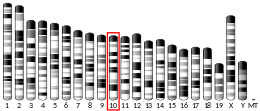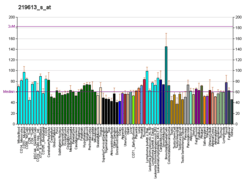Sirtuin 6
Sirtuin 6 (SIRT6 or Sirt6) is a stress responsive protein deacetylase and mono-ADP ribosyltransferase enzyme encoded by the SIRT6 gene.[5][6] SIRT6 functions in multiple molecular pathways related to aging, including DNA repair, telomere maintenance, glycolysis and inflammation.[5]
Function
Studies in mice have revealed that Sirt6 is essential for post-natal development and survival. Sirt6 knock-out mice, in which the gene encoding Sirt6 has been disrupted, exhibit a severe progeria, or premature aging syndrome, characterized by spinal curvature, greying of the fur, lymphopenia and low levels of blood glucose.[7] The lifespan of Sirt6 knock-out mice is typically one to three months, dependent upon the strain in which the Sirt6 gene has been deleted. By contrast, wild type mice, which retain expression of Sirt6, exhibit a maximum lifespan of two to four years.[7]
Mice which have been genetically engineered to overexpress, or produce more, Sirt6 protein exhibit an extended maximum lifespan. This lifespan extension, of about 15–16 percent, is observed only in male mice.[8] Reciprocal regulation between SIRT6 and miRNA-122 controls liver metabolism and Predicts Hepatocarcinoma prognosis by study of Haim Cohen's lab with mice. they found that SIRT6 and miR-122 negatively regulate each other's expression. The study found SIRT6 was shown to act as a tumor suppressor that blocks the Warburg effect in cancer cells.[9]
DNA repair
SIRT6 is a chromatin-associated protein that is required for normal base excision repair of DNA damage in mammalian cells.[10] Deficiency of SIRT6 in mice leads to abnormalities that overlap with aging-associated degenerative processes.[10]
SIRT6 also promotes the repair of DNA double-strand breaks by the process of non-homologous end joining. SIRT6 stabilizes the repair protein DNA-PKcs (DNA-dependent protein kinase catalytic subunit) at chromatin sites of damage.[11]
As normal human fibroblasts replicate and progress towards replicative senescence the capability to undergo homologous recombinational repair (HRR) declines.[12] However, over-expression of SIRT6 in “middle-aged” and pre-senescent cells strongly stimulates HRR.[12] This effect depends on the mono-ADP ribosylation activity of poly(ADP-ribose) polymerase (PARP1). SIRT6 also rescues the decline in base excision repair of aged human fibroblasts in a PARP1 dependent manner.[13] These findings suggest that SIRT6 expression may slow the aging process by facilitating DNA repair (see DNA damage theory of aging).
Clinical relevance
The medical and therapeutic relevance of SIRT6 in humans remains unclear. SIRT6 may be an attractive drug target for pharmacological activation in several diseases.[14] Because SIRT6 attenuates glycolysis and inflammation, the gene is of medical interest in the context of several diseases, including diabetes and arthritis.[15] Additionally, SIRT6 may be relevant in the context of cancer. Several studies have indicated that SIRT6 is selectively inactivated during oncogenesis in a variety of tumor types; a separate study demonstrated that SIRT6 overexpression was selectively cytotoxic to cancer cells.[16] Neurodegenerative diseases in seniors (including Alzheimer's) appear concurrently with low levels of SIRT6.[17]
Activators
Sirt6 deacetylation activity can be stimulated by high concentrations (several hundred micromolar) of fatty acids,[18] and more potently by a first series of synthetic activators based on a pyrrolo[1,2-a]quinoxaline scaffold.[19] Crystal structures of Sirt6/activator complexes show that the compounds exploit a SIRT6 specific pocket in the enzyme's substrate acyl binding channel.[19]
References
- GRCh38: Ensembl release 89: ENSG00000077463 - Ensembl, May 2017
- GRCm38: Ensembl release 89: ENSMUSG00000034748 - Ensembl, May 2017
- "Human PubMed Reference:". National Center for Biotechnology Information, U.S. National Library of Medicine.
- "Mouse PubMed Reference:". National Center for Biotechnology Information, U.S. National Library of Medicine.
- Frye RA (July 2000). "Phylogenetic classification of prokaryotic and eukaryotic Sir2-like proteins". Biochemical and Biophysical Research Communications. 273 (2): 793–98. doi:10.1006/bbrc.2000.3000. PMID 10873683.
- "Entrez Gene: SIRT6 sirtuin (silent mating type information regulation 2 homolog) 6 (S. cerevisiae)".
- Lombard DB, Schwer B, Alt FW, Mostoslavsky R (February 2008). "SIRT6 in DNA repair, metabolism and ageing". Journal of Internal Medicine. 263 (2): 128–41. doi:10.1111/j.1365-2796.2007.01902.x. PMC 2486832. PMID 18226091.
- Kanfi Y, Naiman S, Amir G, Peshti V, Zinman G, Nahum L, Bar-Joseph Z, Cohen HY (February 2012). "The sirtuin SIRT6 regulates lifespan in male mice". Nature. 483 (7388): 218–21. Bibcode:2012Natur.483..218K. doi:10.1038/nature10815. PMID 22367546.
- Elhanati S, Ben-Hamo R, Kanfi Y, Varvak A, Glazz R, Lerrer B, Efroni S, Cohen HY (January 2016). "Reciprocal Regulation between SIRT6 and miR-122 Controls Liver Metabolism and Predicts Hepatocarcinoma Prognosis". Cell Reports. 14 (2): 234–42. doi:10.1016/j.celrep.2015.12.023. PMID 26748705.
- Mostoslavsky R, Chua KF, Lombard DB, Pang WW, Fischer MR, Gellon L, Liu P, Mostoslavsky G, Franco S, Murphy MM, Mills KD, Patel P, Hsu JT, Hong AL, Ford E, Cheng HL, Kennedy C, Nunez N, Bronson R, Frendewey D, Auerbach W, Valenzuela D, Karow M, Hottiger MO, Hursting S, Barrett JC, Guarente L, Mulligan R, Demple B, Yancopoulos GD, Alt FW (January 2006). "Genomic instability and aging-like phenotype in the absence of mammalian SIRT6". Cell. 124 (2): 315–29. doi:10.1016/j.cell.2005.11.044. PMID 16439206.
- McCord RA, Michishita E, Hong T, Berber E, Boxer LD, Kusumoto R, Guan S, Shi X, Gozani O, Burlingame AL, Bohr VA, Chua KF (January 2009). "SIRT6 stabilizes DNA-dependent protein kinase at chromatin for DNA double-strand break repair". Aging. 1 (1): 109–21. doi:10.18632/aging.100011. PMC 2815768. PMID 20157594.
- Mao Z, Tian X, Van Meter M, Ke Z, Gorbunova V, Seluanov A (July 2012). "Sirtuin 6 (SIRT6) rescues the decline of homologous recombination repair during replicative senescence". Proceedings of the National Academy of Sciences of the United States of America. 109 (29): 11800–05. Bibcode:2012PNAS..10911800M. doi:10.1073/pnas.1200583109. PMC 3406824. PMID 22753495.
- Xu Z, Zhang L, Zhang W, Meng D, Zhang H, Jiang Y, Xu X, Van Meter M, Seluanov A, Gorbunova V, Mao Z (2015). "SIRT6 rescues the age related decline in base excision repair in a PARP1-dependent manner". Cell Cycle. 14 (2): 269–76. doi:10.4161/15384101.2014.980641. PMC 4614943. PMID 25607651.
- Cen Y, Youn DY, Sauve AA (2011). "Advances in characterization of human sirtuin isoforms: chemistries, targets and therapeutic applications". Current Medicinal Chemistry. 18 (13): 1919–35. doi:10.2174/092986711795590084. PMID 21517779.
- Liu TF, Vachharajani VT, Yoza BK, McCall CE (July 2012). "NAD+-dependent sirtuin 1 and 6 proteins coordinate a switch from glucose to fatty acid oxidation during the acute inflammatory response". The Journal of Biological Chemistry. 287 (31): 25758–69. doi:10.1074/jbc.M112.362343. PMC 3406663. PMID 22700961.
- Van Meter M, Mao Z, Gorbunova V, Seluanov A (September 2011). "SIRT6 overexpression induces massive apoptosis in cancer cells but not in normal cells". Cell Cycle. 10 (18): 3153–58. doi:10.4161/cc.10.18.17435. PMC 3218623. PMID 21900744.
- Kaluski S, Portillo M, Besnard A, Stein D, Einav M, Zhong L, Ueberham U, Arendt T, Mostoslavsky R, Sahay A, Toiber D (March 2017). "Neuroprotective Functions for the Histone Deacetylase SIRT6". Cell Reports. 18 (13): 3052–62. doi:10.1016/j.celrep.2017.03.008. PMC 5389893. PMID 28355558. Lay summary – The Times of Israel.
- Feldman JL, Baeza J, Denu JM (October 2013). "Activation of the protein deacetylase SIRT6 by long-chain fatty acids and widespread deacylation by mammalian sirtuins". The Journal of Biological Chemistry. 288 (43): 31350–56. doi:10.1074/jbc.C113.511261. PMC 3829447. PMID 24052263.
- You W, Rotili D, Li TM, Kambach C, Meleshin M, Schutkowski M, Chua KF, Mai A, Steegborn C (January 2017). "Structural Basis of Sirtuin 6 Activation by Synthetic Small Molecules". Angewandte Chemie. 56 (4): 1007–11. doi:10.1002/anie.201610082. PMID 27990725.
Further reading
- Maruyama K, Sugano S (January 1994). "Oligo-capping: a simple method to replace the cap structure of eukaryotic mRNAs with oligoribonucleotides". Gene. 138 (1–2): 171–04. doi:10.1016/0378-1119(94)90802-8. PMID 8125298.
- Suzuki Y, Yoshitomo-Nakagawa K, Maruyama K, Suyama A, Sugano S (October 1997). "Construction and characterization of a full length-enriched and a 5'-end-enriched cDNA library". Gene. 200 (1–2): 149–56. doi:10.1016/S0378-1119(97)00411-3. PMID 9373149.
- Parenti MD, Grozio A, Bauer I, Galeno L, Damonte P, Millo E, Sociali G, Franceschi C, Ballestrero A, Bruzzone S, Del Rio A, Nencioni A (June 2014). "Discovery of novel and selective SIRT6 inhibitors". Journal of Medicinal Chemistry. 57 (11): 4796–804. doi:10.1021/jm500487d. PMID 24785705.




